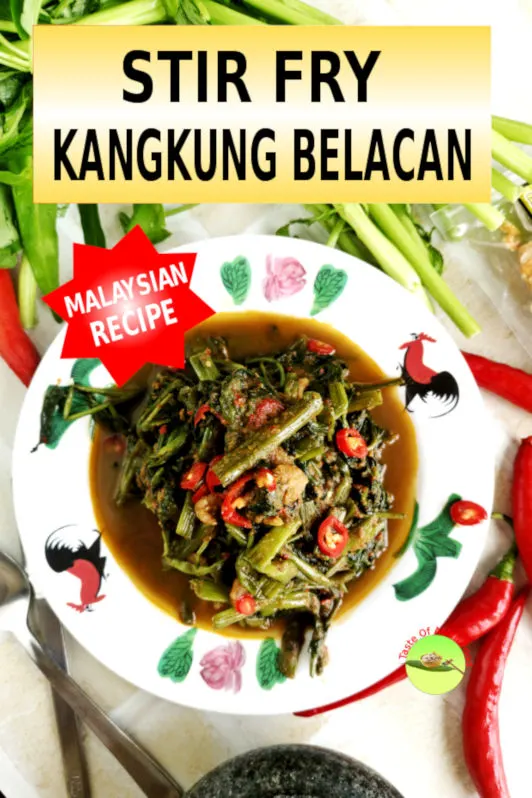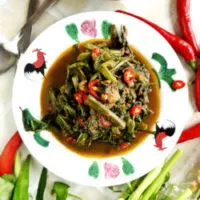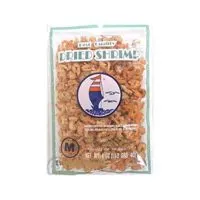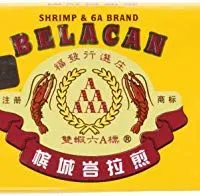Stir fry kangkung with belacan is an authentic home cook food for the Malaysian. This kangkung recipe so well accepted that it has assimilated into the cooking culture of different ethnic groups in this country.
I will explain how to cook kangkung with belacan from the perspective of a Malaysian Chinese. My kangkung recipe may be slightly different from the Malay version, but share the common characteristic of using plenty of chilies and belacan. I will stay true to the authenticity of the recipe. So, please adjust the level of spiciness accordingly!
Let me mention what is kangkung and belacan before going into the nitty-gritty of the preparation. You may skip this if you are familiar with these items, but I know there are a large number of readers who live outside of Asia who may want some information.

Note: This post may contain affiliate links. Please read my privacy policy for more info. I may receive commissions for purchases made through links in this post.
Kangkung
This plant is a type of sub-aquatic vegetable widely available in South East Asia. It has a hollow stem.
Therefore, it is termed as kongxincai (空心菜) in Mandarin Chinese, which means ‘hollow vegetable.’ The Malaysian Chinese however, called it ong choy (蕹菜) in Cantonese. Kangkung is also spelled as kangkong in Malay and Indonesian language.
The English translation is water spinach, river spinach, and water morning glory. These terms are all unfamiliar to the local vegetable vendors, and very likely they do not know about these translations. Therefore, I will use the term ‘kangkung’ throughout the following sections in this article.
Kangkung is best for stir fry as the leaves soak up the sauce and the stems provide a contrasting crunchy texture.
Belacan
Belacan is the name of the shrimp paste popular in Malaysia and Singapore. It is primarily made with krills and salt and fermented for several months.
Belacan is sold in a solid brown color block wrapped in paper. It has a pungent aroma, and therefore a little goes a long way in cooking. The closest form of shrimp paste to belacan is terasi, the Indonesian version of the shrimp paste.
This shrimp paste screams umami! Belacan and terasi are widely used to make sambal, the chili paste for a variety of cuisine.
Sambal
The word ‘sambal’ refers to the local chili paste prepared with chili, onion, and garlic. There are many types of sambal available, as a result of various additional ingredients added to the basic recipe. The sambal in this recipe is combined with belacan and hence is named kangkung with belacan.
Note: Every household in Malaysia make their sambal at home. However, you can purchase the store-bought sambal oelek for convenience to simplify the cooking process. It is available in Asian grocery stores in many countries.
How to stir fry kangkung belacan
Below are the detail steps on how to stir-fry kangkung with belacan.
1. Wash the kangkung thoroughly
Discard the fibrous section close to the root.
Kangkung is quite gritty and must be washed with copious amounts of water. I suggest to clean it in the kitchen sink thoroughly. Drain the kangkung in a colander before use.
2. Separate the stems from the leaves
Divide the kangkung into the stems and leaves sections. Cut the stems into five cm short sections. Don’t be stingy. Cut off the first fifteen centimeters from the root as it is too fibrous. It will now turn soft even cooking for five minutes.
Since the stems need a longer time to turn soft, we will stir fry the stems for two minutes before adding the leaves. The leaves only need one minute of stir-frying to become soft and wilt.
3. Blend the ingredients for the sambal
The sambal of this kangkung recipe contain the toast the belacan and soak the dried shrimps.
Toast the belacan
It is better to use the toasted belacan for making the sambal.
- Break up the belacan if it comes in a block.
- Place the belacan in a saucepan without oil and toast it until it begins to smoke. Remove. Toasting the belacan will remove the unwanted raw and the fishy smell. It also helps to bring out its umami flavor.
I like to add all the oil for sauteing to the mixer and blend with the spices because the oil facilitates blending. You may add a small amount of water if it is too dry.
You may also want to try out the Malaysian satay and kapitan chicken on this blog. They both contain belacan. Check it out if you like its high umami flavor.
Soak the dry shrimps
Clean the dry shrimps with water. Soak it in water for at least ten minutes until it becomes soft. Coarsely chopped it before adding it to the mixer.
Chilies
Cut the chiles into small sections. Do not reduce the number of chilies as it will affect the flavor. Remove the seeds if you want to reduce the spiciness. You can also substitute the bird’s eye chilies with an equal amount of red chili to minimize the hotness.
Prepare the sambal by blending all the ingredients with an electric blender. You can use a mortar and pestle to prepare a small amount or to yield a more rustic texture. I prefer sambal with a smooth texture, but some locals like it coarser by grinding the spices manually.
4. Saute the sambal
Remove the sambal paste from the blender. Saute over low heat until all the water has evaporated. By then, the spices will be cooked by the oil, which turns aromatic.

5. Stir fry the stem, then the leaves
- Now add the stems to the sambal. Stir fry over medium heat for two minutes. You can add one to two tablespoons of water if it is too dry.
- Add the salt and sugar.
- The stems should be no longer hard by now but not too soft until it loses the crunchiness.
- Add the leaves and continue to stir fry until it wilts down about one minute.
- Check the amount of liquid in the wok. It should have reduced to a thick sauce by now. The liquid should have been absorbed by the leaves and clung on to the stems.
- Dish out and serve with steamed rice.
Variations
What if you do not like kangkung?
You can improvise this kangkung recipe by using other vegetables. My favorite is French beans and asparagus. You need to adjust the cooking time for different types of vegetables.

Stir-fry Belacan with Kangkung Recipe
Stir fry kangkung with belacan is an authentic home cook food for the Malaysian. It’s so well accepted that it has to assimilate into the cooking culture of different ethnic groups.
Ingredients
- 400g kangkung (dry weight)
For the sambal
- 150g onion (about 1 medium size)
- 4 cloves garlic
- 3 red chilies
- 3 bird’s eye chilies
- 22g (1.5 tbsp) belacan, toasted
- 15g (1 tbsp) dried shrimps, soaked
- 30ml (2 tbsp) cooking oil
Others
- 1/2 tsp salt
- 1/2 tsp sugar
- Red chili to garnish
Instructions
- Discard the fibrous section of the kangkung (close to the root).
- Wash the kangkung thoroughly
- Drain the kangkung in a colander before use.
- Separate the stems from the leaves
- Cut to divide the kangkung into the stems and leaves sections. Cut the stems into five cm short sections.
- Place the belacan in a saucepan without oil and toast it until it begins to smoke. Remove.
- Clean the dry shrimps with water. Soak it in water for at least ten minutes until it becomes soft. Coarsely chopped.
- Blend all the ingredients for the sambal until smooth.
- Saute the sambal over low heat until aromatic.
- Add the stems and stir fry over medium heat for two minutes. You can add one to two tablespoons of water if it is too dry.
- Add the salt and sugar.
- Add the leaves and continue to stir fry until it wilts down.
- Dish out and serve with steamed rice.
Kangkung
Sambal
Stir-frying
Recommended Products
As an Amazon Associate and member of other affiliate programs, I earn from qualifying purchases.
-
 NutriBullet NBR-1201 12-Piece High-Speed Blender/Mixer System, Gray (600 Watts)
NutriBullet NBR-1201 12-Piece High-Speed Blender/Mixer System, Gray (600 Watts) -
 Dried shrimp - 3 oz
Dried shrimp - 3 oz -
 ChefSofi Mortar and Pestle Set - Unpolished Heavy Granite for Enhanced Performance and Organic Appearance - INCLUDED: Anti-Scratch Protector + Italian Recipes EBook - 6 Inch, 2 Cup-Capacity
ChefSofi Mortar and Pestle Set - Unpolished Heavy Granite for Enhanced Performance and Organic Appearance - INCLUDED: Anti-Scratch Protector + Italian Recipes EBook - 6 Inch, 2 Cup-Capacity -
 Belacan Shrimp Paste - Shrimp & 6A Brand (250g/8.82oz) Product of Malaysia
Belacan Shrimp Paste - Shrimp & 6A Brand (250g/8.82oz) Product of Malaysia
Nutrition Information:
Yield: 2 Serving Size: 1Amount Per Serving: Calories: 470Total Fat: 25gSaturated Fat: 6gTrans Fat: 0gUnsaturated Fat: 14gCholesterol: 56mgSodium: 1686mgCarbohydrates: 41gFiber: 5gSugar: 15gProtein: 27g
This data was provided and calculated by Nutritionix on 9/9/2019

Margaret
Monday 27th of April 2020
Hello Kwan I lived in Malaysia for 3 years and still return to visit friends. Kangkong goreng was one of my favorite dishes. I got some seeds and planted them. I have now harvested them so I was very happy to find your recipe to try to reproduce this dish. I wanted to give you a like and subscribe but I couldn't find the place to do it.
KP Kwan
Tuesday 28th of April 2020
Hi Margaret, Thank you for reading my article, and glad to know that you are hooked on kangkung during your stay in Malaysia :) You can subscribe to my newsletter by filling up the subscription box ( and a free recipe book) below the recipe in every article. With that, you will receive my update through email. Of course, there is an unsubscribe option in the email should you think you want to stop receiving it. KP Kwan
KP Kwan
Tuesday 10th of September 2019
Hi, this is KP Kwan. I am happy to see you in this comment area, as you have read through my recipe. I am pleased to reply to any questions and comments as soon as possible.